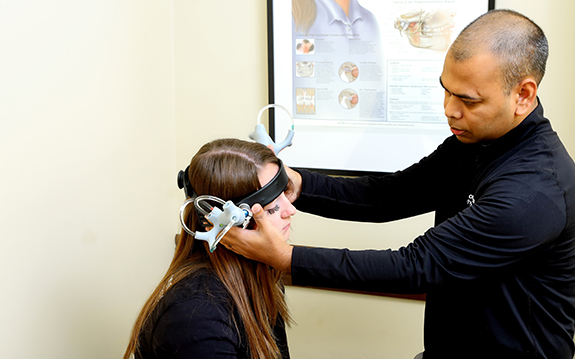The vestibular system is a sensory system in the inner ear that contributes to our balance and spatial orientation. It consists of two main components, the semi-circular canals, and the otolith organs. The semi-circular canals detect rotation of the head such as nodding your head “yes” or shaking your head “no.” The otolith organs are more sensitive to gravity and detect linear acceleration of the head such as moving forward in a car or up in an elevator. We have some important visual-vestibular reflexes that help coordinate our eye movements with our head movements. One example is the vestibular-ocular reflex which helps stabilize an image on the retina during head movements. Another example is the optokinetic reflex which allows us to follow a moving object. After a concussion, changes in brain processing and vestibular system function impact these reflexes.

How does vestibular rehabilitation work?
Vestibular rehabilitation is a specialized form of therapy designed to reduce dizziness, headaches, and imbalance. It involves an individualized problem-oriented approach to promote compensation and brain adaptation. Your physical therapist will customize exercises to address each person’s specific problems. Based on your examination findings, three principal methods of exercise can be prescribed: gaze stabilization, habituation, and balance/exertional training.
How can I recover faster?
An important part of vestibular rehabilitation is to establish an exercise program that is performed regularly at home. The brain needs thousands of repetitions to make changes, so following this home exercise program is essential in helping you meet your goals. Exercise may make symptoms seem worse initially, but with time and consistent work, they should steadily decrease. Participating in a comprehensive vestibular rehabilitation and home exercise program will allow those who sustained a concussion to return to full activities like school, work, and competitive sports.
Symptoms
Concussion symptoms that may indicate a disruption of the vestibular system include
- Loss of Balance
- Dizziness or Spinning
- Eye Strain
- Blurred Vision
- Headaches
- Fatigue
The symptoms can occur right away or they can develop up to several weeks after the concussion. Patients will have different combinations of symptoms.
What Happens to Your Brain During a Concussion?
The brain is made of very soft material, almost like jello, and is usually well protected by the skull and membrane, but it is not invincible. Human heads are not made to sustain sudden jolts and hard impacts, so when that happens, the brain will jostle and move within the skull, causing damage to the brain. When the brain impacts the skull, it causes the neurons to stretch and sometimes break. Neurons make the brain function properly, almost like wires for transferring electricity, and when one of the wires malfunctions, nothing works quite right. One of the functions that might be affected by damaged neurons is the vestibular system.
